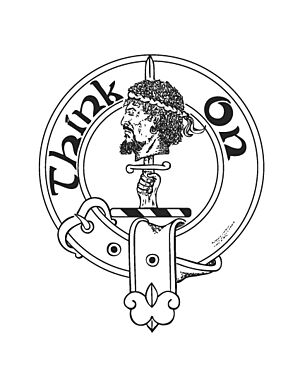Black Morrow facts for kids
Black Morrow, also known as Black Murray or Outlaw Murray, was a famous Scottish outlaw from the late 1400s. His story is told in old songs and traditions. Some stories say he lived in Ettrick Forest, while others place him in a wood in Kirkcudbrightshire.
People had different ideas about where Black Morrow came from. Some thought he was a Romani or Scottish Traveller. Others believed he was from Ireland, or even described him as a Moor or Saracen. The idea that he might have had dark skin led to discussions about the meaning of "Black" in his name.
Stories and Songs
The story of Black Morrow was written down in different ways. One popular version is a long song called "An Old Song Called Outlaw Murray." This song was published in books like Minstrelsy of the Scottish Border by Walter Scott in 1803. It shows that the story was known even before the 1700s.
Walter Scott believed the song was created around the time of James V, a Scottish king. In the song, the outlaw is simply called Outlaw Murray. It doesn't mention him being a Gypsy, Saracen, or Moor.
There's also another version of the story, passed down through spoken word, which was written down in 1680. This version is a bit different from the song.
What the Stories Say
The song and the spoken traditions both agree that Black Morrow was a powerful bandit living in a Scottish forest in the late 1400s. In the song, he even owned a strong castle within the woods!
Walter Scott described Outlaw Murray as incredibly strong. He used a large club to cause trouble across the countryside. This sounds a lot like the bandit in the spoken stories.
However, there are some differences:
- In the song, Black Morrow lives in Ettrick Forest.
- In the spoken tradition, he lives in a wood in Kirkcudbrightshire.
- In the spoken tradition, a man from Clan MacLellan named William Maclellan is said to have killed the outlaw. He supposedly took the outlaw's head to the King. This is why a Moor's head became a symbol on the crest of the Maclellan family. But in the song, the outlaw is not killed.
Why "Black" in His Name?
The word "Black" in Black Murray or Black Morrow has a few possible meanings:
- Dark Skin: Some people believed it referred to the bandit having dark skin, like a Moor. This idea connects to the Moor's head symbol on the crest badge of Clan MacLellan.
- The Wood's Name: Another idea is that the name came from a wood in Kirkcudbrightshire called "Black Morrow (Plantation)" where he lived. But it's also possible the wood was named after the outlaw!
- His Actions: It could also describe his bad deeds, evil nature, or grim personality.
Historian David MacRitchie strongly believed the outlaw was dark-skinned.
See also


